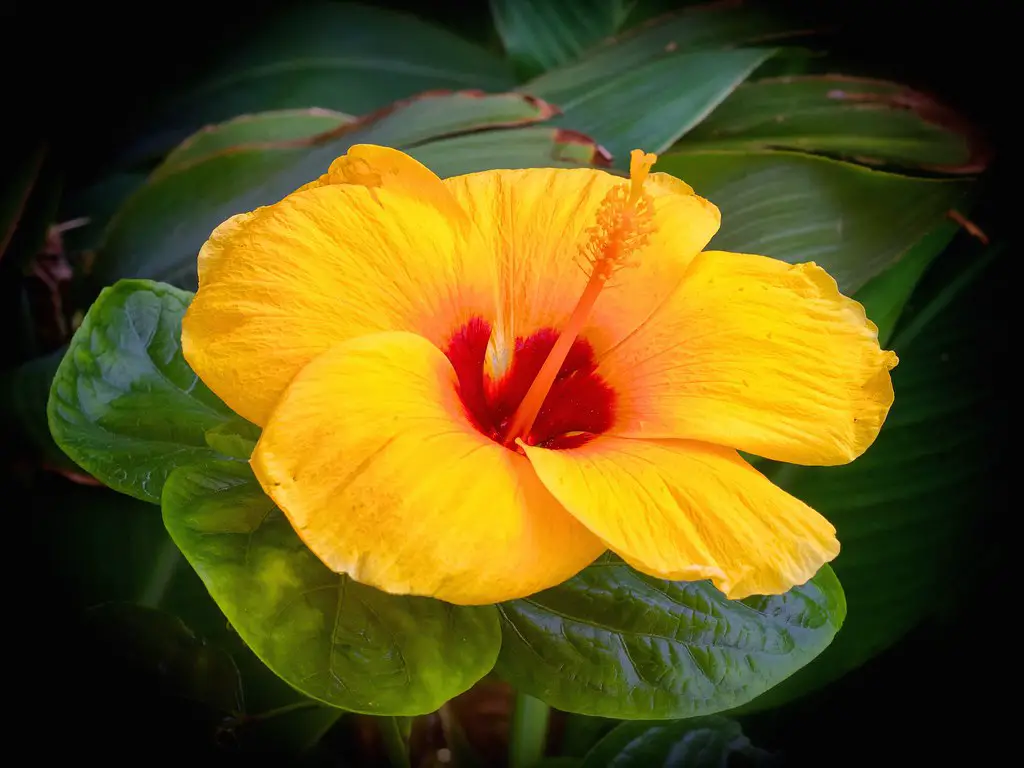Hibiscus, a genus containing over 200 species, is famous for its large, showy flowers that come in a variety of vibrant colors. Known for its tropical appearance, the Hibiscus has become a symbol of beauty and exotic landscapes, evoking images of tropical islands and serene beaches. These flowers have been used in various cultures for medicinal, culinary, and ornamental purposes. Hibiscus tea, made from the sepals, is a popular beverage in many cultures.
Despite its tropical appearance, many hibiscus plants are quite hardy and can be grown in a wide range of climates. Some species, like Hibiscus syriacus, can withstand cold winters, while others, such as Hibiscus rosa-sinensis, are more suitable for tropical and subtropical regions. The diverse nature of this genus means that there’s a hibiscus to suit almost any garden.
A member of the mallow family (Malvaceae), hibiscus is not only prized for its aesthetic appeal but also for its ease of care. Whether grown as a potted plant indoors or cultivated outdoors, it adds a touch of the tropics to the home or garden. From towering shrubs to compact varieties, the adaptability and charm of hibiscus make it a beloved plant worldwide.
| Attribute | Details |
|---|---|
| Common Names | Hibiscus, Rose mallow |
| Botanical Name | Hibiscus |
| Family | Malvaceae |
| Plant Type | Perennial or Annual, depending on species |
| Mature Size | 4-15 feet tall, 3-8 feet wide |
| Sun Exposure | Full sun |
| Soil Type | Well-drained, fertile soil |
| Hardiness Zones | 5-11, depending on species |
| Native Area | Asia, Pacific Islands, Africa, North America |
Hibiscus Care
Caring for Hibiscus requires attention to its basic needs like sunlight, soil quality, and water. Though generally robust, different species of Hibiscus may have specific requirements. Tropical hibiscus loves warmth and humidity, while hardy hibiscus can withstand colder climates.
Most hibiscus plants prefer a sunny location with well-draining soil enriched with organic matter. Regular watering and feeding, especially during the growing season, can promote lush growth and abundant flowering. Additionally, proper pruning and protection from pests and diseases can keep the plant healthy and vibrant.
Light Requirement for Hibiscus
Hibiscus thrives in full sun. A minimum of 6 hours of direct sunlight is essential for healthy growth and abundant flowering. In particularly hot climates, some afternoon shade may be beneficial.
Soil Requirements for Hibiscus
Well-drained and fertile soil rich in organic matter suits Hibiscus best. A slightly acidic soil with a pH ranging from 6.0 to 6.8 is ideal, but the plant can adapt to different soil types.
Water Requirements for Hibiscus
Hibiscus requires consistent watering, especially in the growing season. The soil should be kept moist but not soggy. Reducing water in winter is advisable for species that go dormant.
Temperature and Humidity
Tropical hibiscus thrives in warm temperatures and high humidity, while hardy hibiscus can tolerate cooler conditions. Protection from cold drafts and freezing temperatures is necessary for tropical varieties.
Fertilizer
A balanced fertilizer with regular applications during the growing season supports healthy growth. Specialized hibiscus fertilizers with added micronutrients can be particularly beneficial.
Pruning Hibiscus
Pruning can be done in late winter or early spring to shape the plant and remove dead or weak growth. Regular deadheading encourages more blooms.
Propagating Hibiscus
Hibiscus can be propagated through cuttings, division, or seeds. Cuttings taken in spring or early summer have the best chance of success.
How To Grow Hibiscus From Seed
Growing hibiscus from seed can be a rewarding process. Seeds can be sown indoors in late winter or directly outdoors after the last frost. Soaking seeds and providing a warm, well-lit environment can aid germination.
Common Pests & Plant Diseases
Aphids
Aphids can be controlled using insecticidal soap or neem oil.
Spider Mites
Regularly misting and wiping leaves can prevent spider mite infestations.
Rust and Blight
These can be controlled with proper spacing, airflow, and fungicides if necessary.
Common Problems With Hibiscus
Yellowing Leaves
This could indicate water stress or nutrient deficiencies. Regular watering and fertilizing can often resolve this issue.
Bud Drop
Bud drop can occur due to sudden temperature changes, over-watering, or pests. Careful monitoring and adjustments to care can prevent this problem.
Weak Blooms
Insufficient sunlight or poor soil can lead to weak or sparse blooming. Ensuring adequate light and nutrient-rich soil can enhance flowering.
Pro Tips
- Select the right variety of hibiscus for your climate and space.
- Provide ample sunlight and well-draining soil.
- Water and feed regularly during the growing season.
- Monitor for pests and diseases, taking prompt action if needed.
- Prune and deadhead to encourage healthy growth and more blooms.




